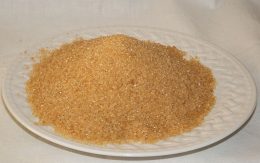Making candy is the science of cooking sugar. Success depends on many factors.
- Use a heavy saucepan with metal that conducts heat, such as aluminum.
- Use a big pan to prevent boiling over. This is especially true if using molasses.
- The pan should fit the burner or be just a little smaller than the burner. This keeps the pan sides hot and reduces crystal formation.
- Heat and stir the mixture over low heat to dissolve all sugar crystals. Before the target temperature is reached, brush pan sides with water to wash sugar crystals back into the syrup or put the lid on the pan for steam to melt sugar on pan sides.
- Once sugar is dissolved, attach a candy thermometer inside the pan and do not move it.
- Once desired temperature is reached, do not scrape the pan or put a used spoon in the mixture. That will cause crystal formation.
Source: Cookwise, by Shirley Corriher

